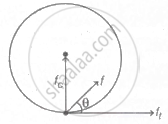Advertisements
Advertisements
प्रश्न
A child starts running from rest along a circular track of radius r with constant tangential acceleration a. After time the feels that slipping of shoes on the ground has started. The coefficient of friction between shoes and the ground is [g = acceleration due to gravity].
पर्याय
`(["a"^4"t"^4 + "a"^2"r"^2]^(1/2))/"gr"`
`(["a"^4"t"^4 + "a"^2"r"^2])/"rg"`
`(["a"^2"t"^2 + "a"^4"r"^4])/"rg"`
`(["a"^4"t"^4 - "a"^2"r"^2]^(1/2))/"rg"`
उत्तर
`(["a"^4"t"^4 + "a"^2"r"^2]^(1/2))/"gr"`
Explanation:
When child moves in a circular track, he is acted upon by two force as shown below.

Here, fc = f sin Sand ft = f cos θ.
As, fc is the centripetal force and ft is the tangential force. So,
`"f"_"c" = "mv"^2/"r"`= f cos θ
and ft = ma = f cos θ
∴ Resultant force, fR = `sqrt(("f" sin theta)^2 + ("f" cos theta)^2)`
`= sqrt(("mv"^2/"r")^2 + ("ma")^2)`
Also, when the shoes starts slipping, the friction becomes equal to resultant force.
∴ f = fR
`mu "mg" = sqrt(("mv"^2/"r")^2 + ("ma")^2)`
`=> mu^2 "m"^2 "g"^2 = ("m"^2"v"^4)/"r"^2 + "m"^2"a"^2`
`=> mu^2"g"^2 = (("at")^4 + "a"^2"r"^2)/"r"^2 ....(because "a" = "v"/"t")`
or `mu = (["a"^4"t"^4 + "a"^2"r"^2]^(1/2))/"gr"`
